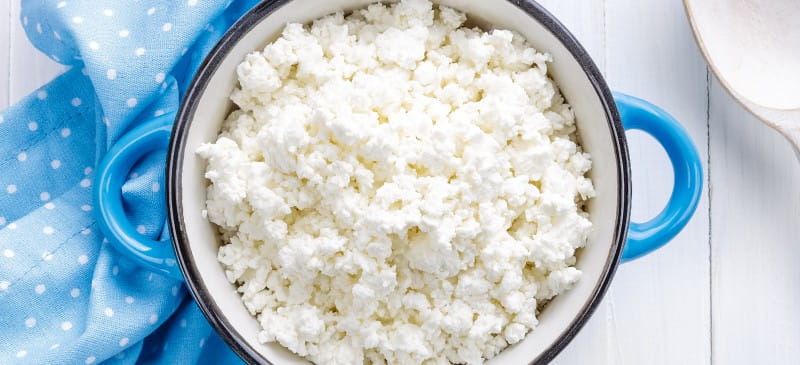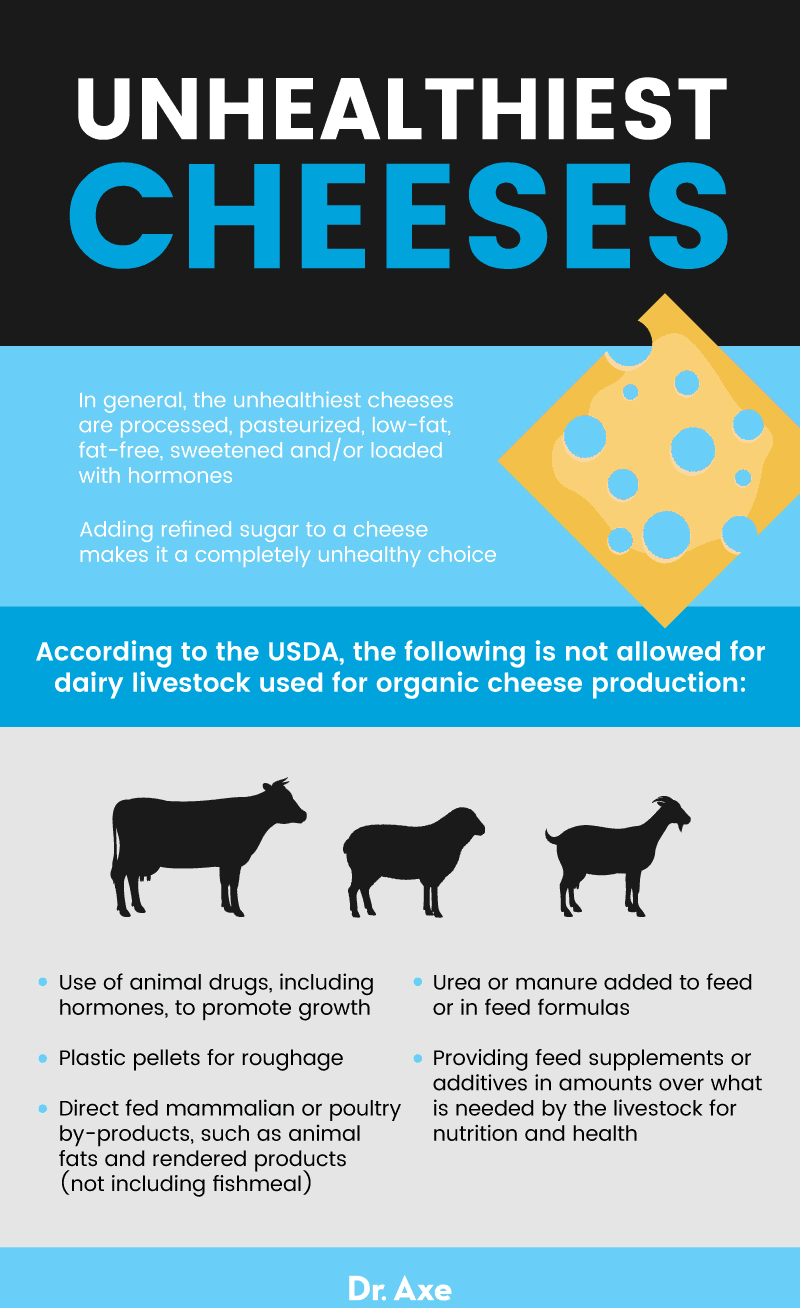Discovering the Healthiest Cheese Options
Is Cheese Bad for You? Top 5 Healthiest Cheese Options & Benefits
Cheese

What is the healthiest cheese to eat? The healthiest type of cheese is debatable, but there are certainly cheeses that are clearly healthier than others.
There are also specific qualities — such as certified USDA organic and raw — that can make a cheese more health-promoting in our bodies.
Is cheese bad for you? Like so many other food staples, such as meat, it’s not about demonizing an entire genre of foods — it’s about making the right choices. In this instance, you want to opt for the healthiest cheese options around, making sure your cheese of choice comes from a responsible source and from grass-fed animals, whether we’re talking cheese from cows, goat cheese or some other source.
After reading this article, you should hopefully feel better equipped to make healthy selections in the cheese department.
Healthiest Cheese Options
These are some of my favorite cheeses because they are also some of the healthiest cheeses. Just make sure to buy them in their optimal state, which means unprocessed, raw, certified organic and ideally from grass-fed animals.
Raw is really important since pasteurization has been shown to reduce vitamin, protein and enzyme levels in milk. This has even been shown in studies where human breast milk went through a pasteurization process. (1)
Feta Cheese
Feta cheese is without a doubt one of the healthiest cheeses around. What is feta cheese exactly? It’s a cheese that can be created using sheep milk, goat milk or a combination of the two. Since feta is made from sheep/goat milk rather than cow milk, it’s known for being easier on the digestive system and much less inflammatory than cheeses from cow milk.
Many people who can’t tolerate cow’s milk cheeses are OK with feta cheese. Look for feta cheese that is raw rather than pasteurized versions. Just remember that feta cheese is naturally high in sodium and saturated fat so it’s best used sparingly and not on a daily basis.
Goat Cheese
Goat cheese is made entirely from nutritionally impressive goat milk. This milk is also praise-worthy in some other ways. It does not contain the A1 casein found in most cow’s milk that so many people have trouble digesting, and it only contains A2 casein so in terms of protein it’s the closest milk to human breast milk. (2) Research suggests that when goat milk is used as the first protein after breastfeeding, it is less allergenic for babies compared to cow milk. (3) Look for raw, unpasteurized and organic goat cheeses.
Cottage Cheese
Cottage cheese is a mild, soft, creamy white cheese. Unlike a lot of other cheese, cottage cheese does not go through an aging process. Many people love to eat it as a satisfying high protein snack. Cottage cheese is available at most grocery stores in non-fat, low-fat and full-fat versions. As usual, I recommend a full fat cottage cheese.
Pecorino Romano Cheese
You’ll often see this healthy cheese in many of my recipes. Pecorino Romano is a hard cheese made from sheep milk. The milk and cheese from sheep aren’t very popular in the United States yet, but they definitely are in other areas around the world, especially the Mediterranean region. Eaten since ancient Roman Times, it’s one of Italy’s oldest cheeses and still made today using the original recipe.
Ricotta Cheese
Ricotta cheese is creamy with a slightly sweet taste. It’s another healthy option in moderation that is a little bit like cottage cheese. Ricotta can be made from several animal milks, but I recommend ricotta made from sheep milk or goat milk. It is created using the whey left over from cheese making. Like cottage cheese, ricotta is considered a “fresh cheese” because it is not aged.

Healthiest Cheese Benefits
Buying these cheeses in their best possible form — made from raw milk, certified organic and ideally from grass-fed animals — means all of these healthy cheeses will provide beneficial protein, key minerals like calcium, enzymes and even probiotics. Plus, full-fat cheese (again, ideally raw and organic) are ketogenic diet-friendly food options.
Here are some of the more specific benefits of each of these healthy cheeses:
Feta Cheese
Feta cheese is naturally high in key nutrients like calcium and riboflavin (vitamin B2). Per serving (about 28 grams), feta also contains significant amounts of phosphorus, vitamin B12 and selenium. (4) So when you eat feta cheese, you’re reaping the benefits of all of these many important vitamins and minerals.
Calcium, for example, is key to heart, nerve and general muscle function. It’s also a mineral that is a must if you want strong teeth and bones. Riboflavin, also impressively high in feta cheese, helps the body to maintain its energy levels. It also acts like an antioxidant so it fights off free radicals that can cause cellular damage. Why is this important? Damage to cells and DNA is known to speed up aging, and more concerning, it’s known to contribute to many serious health concerns including heart disease and cancer.
Goat Cheese
Goat cheese is made from goat milk. Animal research has shown that compared to cow milk, goat milk increases iron absorption while boosting bone formation and the bioavailability of key minerals like calcium. (5)
Goat cheese is loved by many not only for its taste, but for its easy digestibility. According to Walter Vetter, professor of food chemistry at the University of Hohenheim in Germany, who has studied the flavor compounds in goat cheese, “In many instances goat cheese can be consumed by people allergic to cow’s milk.” (6)
Cottage Cheese
Cottage cheese can be a healthy choice if you’re trying to reach ketosis. I don’t recommend overdoing it (since cottage cheese is still a dairy product), but a full-fat cottage cheese can be a helpful choice when you’re following a ketogenic diet.
It’s a high-protein, high-fat food that can keep you satisfied and may even help you reach your weight loss goals. Research has shown that a high-protein diet can increase satiety, thermogenesis, sleeping metabolic rate, protein balance and, last but certainly not least, fat oxidation. (7)
Cottage cheese is also a staple of the Budwig Diet protocol for cancer.
Pecorino Romano Cheese
Sheep milk is richer in protein and fat than either cow or goat milk. It is also higher in lactose. (8) Just one ounce of Pecorino Romano can contain seven grams of protein or more so it’s an excellent source of this key nutrient. (9)
Including a high-protein cheese like this in your diet can help you to avoid a protein deficiency. This is a state of being you definitely want to avoid since it can lead to a sluggish metabolism, trouble losing weight, low energy levels, moodiness and other unwanted symptoms. Sheep’s milk Pecorino Romano is also a rich source of calcium and vitamin A.
Ricotta Cheese
Ricotta made from sheep milk or goat milk is rich and creamy, and with its slightly sweet flavor, it can satisfy a taste for sweets without going overboard. A quarter cup of a sheep milk ricotta cheese contains 100 calories, seven grams of protein and only three grams of sugar. It also contains notable amounts of healthy fatty acids, vitamin A and calcium. (10) Compared to many other cheese options, ricotta cheese is lower in sodium and saturated fat. (11)
Unhealthiest Cheese Options
In general, the unhealthiest cheeses are processed, pasteurized, low-fat, fat-free, sweetened and/or loaded with hormones. As you know, I encourage eating whole foods so taking the fat (some or all) out of cheeses is a big no-no. Not only does this make a cheese less tasty and satisfying, but it also denies the body of that natural fat that helps give us energy and keep our blood sugar balanced.
Sweetening cheese? Yes, it is a thing. Cottage cheese, which can be a really healthy choice, is now often adulterated with “fruit” additions, which are mainly just refined sugar. Adding real whole fruit to cottage cheese isn’t a bad idea, but adding refined sugar to a cheese makes it a completely unhealthy choice. Overconsumption of sugar destroys the body in a number of ways, including an increased risk from dying from heart disease. (12) It’s also a huge contributor to diabetes and the obesity epidemic we’re currently facing around the world (yes, it’s now a global epidemic!). (13)
Cheese that isn’t certified USDA organic can come from animals that have been given hormones. Animals used for organic dairy production must only consume grain and forages that are certified organic.
According to the USDA, the following is not allowed for dairy livestock used for organic cheese production: (14)
- Use of animal drugs, including hormones, to promote growth
- Plastic pellets for roughage
- Urea or manure added to feed or in feed formulas
- Direct fed mammalian or poultry by-products, such as animal fats and rendered products (not including fishmeal)
- Providing feed supplements or additives in amounts over what is needed by the livestock for nutrition and health
So if you don’t go organic with your cheese, all of these unwanted things are likely a part of the creation of the cheese you’re eating. Yuck! Instead, opt for the healthiest cheese options that avoid this practices and come from healthy sources.

Recipes
Ready to start using healthy cheese in your upcoming meals? Here are some of favorite healthiest cheese recipes around:
If you’re having a party or get-together, I highly recommend my Goat Cheese and Artichoke Dip Recipe. It’s a rich and creamy combination that is sure to be a crowd pleaser.
Looking for an easy yet satisfying soup? Look no further than my Creamy Broccoli Soup with Cheese Recipe. With incredible broccoli nutrition plus delicious low-lactose raw cheddar cheese, this truly a soup to love.
Some vegetable-centric side dishes that include a cheesy boost: Roasted Fennel Bulb Recipe With Pecorino Romano and Pistachios or Cheesy Potatoes Au Gratin with Yellow Squash and Zucchini. Another great side dish option is Roasted Beet Salad with crumbled goat cheese.
Wondering how to use cottage cheese other than just by itself? You’ll definitely want to try my Gluten-Free Cauliflower Mac and Cheese Recipe. You won’t miss the gluten or heavily processed cheese at all, I promise! Another great main course option: Vegetarian Baked Ziti Recipe with Goat Cheese.
Risks and Side Effects
If you have an allergy to cow milk, goat milk, sheep milk or any animal milk from which a cheese is derived then unfortunately you must avoid that cheese.
If you have a lactose intolerance, some cheeses will not agree with you, while other low-lactose cheeses may not be problematic. In general, cheeses that have been aged longer, such as cheddar, Parmesan and Swiss, are known to have low levels of lactose.
Always speak to your health care provider if you are feeling unsure about what cheeses are safe for you and your particular health concerns.
Final Thoughts
- Cheese isn’t bad for you as long as you don’t have an allergy or intolerance and you make healthy choices.
- The healthiest cheese options include feta cheese, goat cheese, cottage cheese, sheep milk cheese like Pecorino Romano and ricotta cheese.
- To get the healthiest cheese versions, opt for varieties that are unprocessed, raw and certified organic.
- Many people love cheese. The good news is that if you choose wisely, there are a lot of delicious cheeses that in moderation can be a part of a healthy, whole food-based diet.





Leave a comment